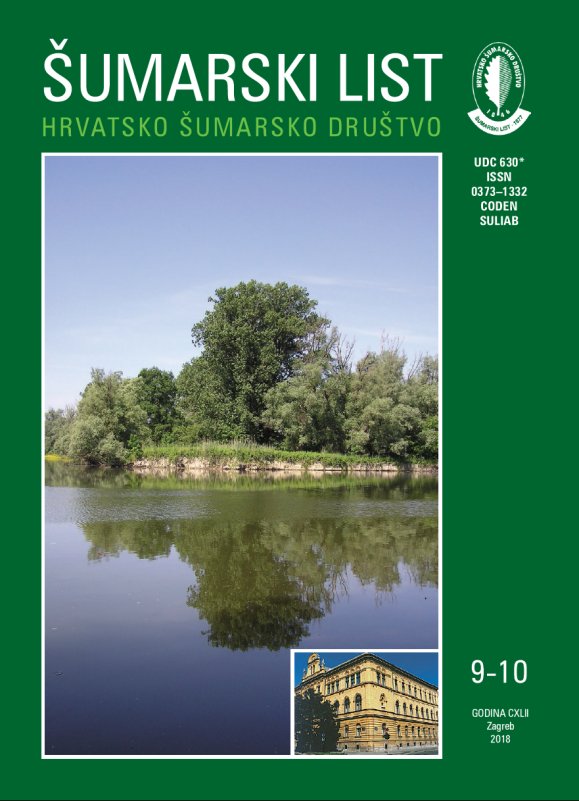
broj: 9-10/2018
pdf (10,64 MB) |
|
||||||||||||||
| RIJEČ UREDNIŠTVA | ||
| Uredništvo | ||
| On the occasion of the 120th anniversary pdf HR EN | 457 | |
| IZVORNI ZNANSTVENI ČLANCI | ||
| Krunoslav Teslak, Marijana Žunić, Karlo Beljan, Jura Čavlović | UDK 630* 923 + 619 (001) https://doi.org/10.31298/sl.142.9-10.1 | |
| Status and challenges of small-scale private forest management in actual ecological and social circumstances – Croatia case study pdf HR EN | 459 | |
| Summary Forest management in Croatia traditionally has been dominantly concentrated and directed toward state owned forests, thus it characterized with continuity and consistency of forest management planning and performance of management treatments, as well as fulfillment of principles of sustainable management on all levels. On the contrary, due to historic circumstances, small share and scattered fragmented forest distribution private forests was significantly uncared for management until not long ago. Thus, aim of this paper is to analyze and to present actual characteristics of private forests, forest estate and forest owners, as well as management circumstances namely institutional and legislative framework in which it is exists. Share of 24 % according to area and growing stock of 156 m3/ha with richness tree species and tree/stand developmental stages indicate on valuable natural forest resource in Croatia. Although during last years has achieved particular progress, existing property-juridical and land-register questions, unsuitable institutional framework and adverse socio-demographic characteristics of forest owners (large share of old population, low level of education) load with further improvements of private forest management. With absence of complete data base, results of researches and surveys are valuable information sources describing the private forest owner’s characteristics. In consideration on obtained results of average characteristics of forest owners (average age of 60 years, low education level) are not satisfactory, strategy and guidelines making should be based on knowledge of private forest owners preferences and types, especially of that which are active and which are ready to be active in forest management. Thereby, there is need to segregate forest owners which manage their forests and offer forest products on market (recorded in Register) from forest owners which owns small forest parcels and more or less use their forests for their own needs. Improvement of balanced and sustainable private forest management planing would be based on transformation of the existing parallel forest management planning system divided according to categories of forest property (state, private). By integration of all publc competences over forests within unique institution with establishment more forest management regions, would provide fullfilment of requirements of sustainable forest management and long-term public interests. An effective and comprehensive establishment of sustainable private forest management is based on adoptation of knowledge and private forest management particularities including actual results of relevant scientific researches, from the all copartners of the forest management system. Key words: forest management planning; forest property plan; size structure of forest estates; forest owners | ||
| Luka Kasumović, Ake Lindelöw, Boris Hrašovec | UDK 630* 453 (001) https://doi.org/10.31298/sl.142.9-10.2 | |
| Influence of predator abundance and winter mortality on reproduction of bivoltine populations of Ips typographus L. (Coleoptera: Curculionidae) pdf HR EN | 473 | |
| Mirna Mihelčić, Josipa Habuš, Marko Vucelja, Petra Svoboda, Ivan-Christian Kurolt, Alemka Markotić, Nenad Turk, Josip Margaletić, Marina Šantić | UDK 630* 443 + 451 (001) https://doi.org/10.31298/sl.142.9-10.3 | |
| Prevalence of Francisella tularensis in the population of small mammals species in continental forests of Croatia pdf HR EN | 481 | |
| Silvija Šiljeg, Ivan Marić, Gojko Nikolić , Ante Šiljeg | UDK 630* 451 + 153 (001) https://doi.org/10.31298/sl.142.9-10.4 | |
| Accessibility analysis of urban green spaces in the settlement of Zadar in Croatia pdf HR EN | 487 | |
| Mădălina Fornea, Marcian Bîrda, Stelian Alexandru Borz, Bogdan Popa, Željko TomaŠić | UDK 630* 360 (001) https://doi.org/10.31298/sl.142.9-10.5 | |
| Harvesting conditions, market particularities or just economic competition: a Romanian case study regarding the evolution of standing timber contracting rates pdf HR EN | 499 | |
| Ali Bayraktar, Fahrettin Atar, Nebahat Yildirim, Ibrahim Turna | UDK 630* 181.5 (001) https://doi.org/10.31298/sl.142.9-10.6 | |
| Effects of different media and hormones on propagation by cuttings of european yew (Taxusaxus baccata L.) pdf HR EN | 509 | |
| Vanja Daničić, Branislav Kovačević, Dalibor Ballian | UDK 630* 164 (001) https://doi.org/10.31298/sl.142.9-10.7 | |
| Variability in fruit morphology of european sweet chestnut (Castanea sativa Mill.) in natural populations in Bosnia and Herzegovina pdf HR EN | 517 | |
| PREGLEDNI ČLANCI | ||
| Xiaoyang Zeng | UDK 630* 114.2 + 272 https://doi.org/10.31298/sl.142.9-10.8 | |
| Influence of tourism disturbance on carbon, nitrogen, and enzyme activities of the soil in an urban park in China pdf HR EN | 529 | |


